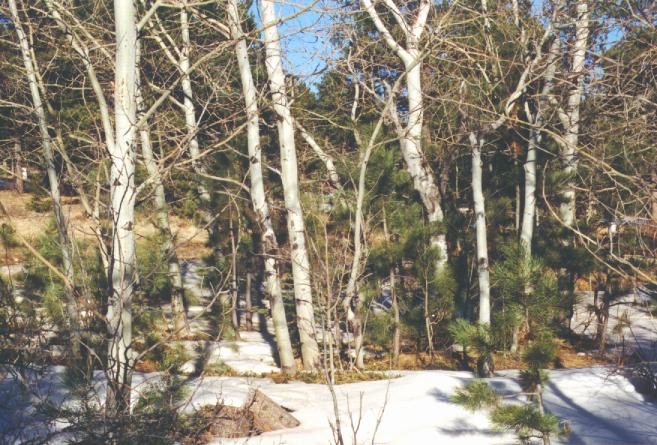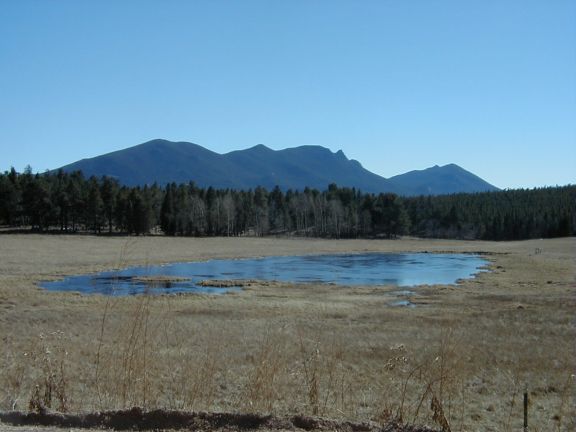


The Planning Area includes many species typical of the foothills and montane life zones of the Front Range. In the western portion of the Planning Area, particularly on north-facing slopes and in wetlands, there are a few species more typical of the subalpine life zone.
Five years of field work were conducted and review of literature and other available information was undertaken to document and describe plant species within the Planning Area. A list of all 121 plant species identified during field work for this report is included in Appendix 4.5. This list is not complete, as more species will be found with additional field work. Many plant species and their preferred habitat are listed under the specific vegetation community descriptions found below.
Ten major vegetation communities were described for this report. The plant communities described generally follow most of those described in the management plan for Boulder County’s Parks and Open Space parcels (Boulder County Parks and Open Space Department, 1998). Plant nomenclature follows the USDA Soil Conservation Service (1994).
Overstory vegetation varies between sites and may include Engelmann spruce (Picea Engelmannii), blue spruce (Picea pungens), narrowleaf cottonwood (Populus angustifolia), and aspen (Populus tremuloides). Box elder (Acer negundo) may be found below 7,200’ elevation.
A mid-layer (shrub) canopy is often present and commonly includes Rocky Mountain maple (Acer glabrum), thinleaf alder (Alnus incana ssp. tenuifolia), water birch (Betula occidentalis), red osier dogwood (Cornus sericea), chokecherry (Prunus virginiana var. melanocarpa), Wood's rose (Rosa woodsii), Bebb willow (Salix bebbiana), coyote willow (Salix exigua) and western snowberry (Symphoricarpos occidentalis). Occasionally, trees are absent, and this shrub layer becomes the dominant overstory vegetation.
Common understory species include smooth brome (Bromus inermis), smooth horsetail (Equisetum laevigatum), Richardson's geranium (Geranium richardsonii), Fendler's waterleaf (Hydrophyllum fendleri), and dandelion (Taraxacum officinale).
The riparian communities along Middle Boulder Creek are considered significant by Boulder County (1998) because of the rarity of this community type. Two variations of the plant community are noted by the County, the presence or absence of narrowleaf cottonwood in the overstory being one of the key differences.
This vegetation community occurs on upland sites at the edges of meadows and in swales with seasonal water saturation, and relatively dry drainages. Aspen forest may also occasionally be the dominant cover in ravines and riparian areas. Aspen dominates the overstory, with conifers often present. Aspen regeneration is variable; however, in most stands conifers are invading and will eventually replace aspen in the absence of ecological disturbances.
 |
| Figure 4.1 Conifers encroaching into an Aspen stand. Aspen, which act as a natural fire break, are decreasing due to the lack of fire and enchroachment by conifers. |
The mid-layer canopy includes Rocky Mountain maple (Acer glabrum), thinleaf alder (Alnus incana ssp. tenuifolia), water birch (Betula occidentalis), red osier dogwood (Cornus sericea), common juniper (Juniperus communis), shrubby cinquefoil (Pentaphylloides floribunda), whitestem gooseberry (Ribes inerme), Wood's rose (Rosa woodsii), Bebb willow (Salix bebbiana), and park willow (Salix monticola). The amount of shrubs present varies greatly from stand to stand.
Typically in aspen forests there is a lush growth of ground cover including yarrow (Achillea millefolium var. occidentalis), red baneberry (Actaea rubra), heart-leaved arnica (Arnica cordifolia), sulphur Indian paintbrush (Castilleja sulphurea), field chickweed (Cerastium arvense), shootingstar (Dodecatheon pulchellum), smooth horsetail (Equisetum laevigatum), meadow horsetail (E. pratense), northern bedstraw (Galium boreale), Richardson's geranium (Geranium richardsonii), cow parsnip (Heracleum sphondylium), Fendler's waterleaf (Hydrophyllum fendleri), iris (Iris missouriensis), osha (Ligusticum porteri), false Solomon's seal (Maianthemum racemosum), starry false Solomon's seal (M. stellatum), mountain bluebells (Mertensia ciliata), bracken fern (Pteridium aquilinum), twisted-stalk (Streptopus amplexifolius), dandelion (Taraxacum officinale), Fendler's meadowrue (Thalictrum fendleri), mountain goldenpea (Thermopsis rhombifolia var. divaricarpa), Canada violet (Viola canadensis), and water sedge (Carex aquatilis).
This community is most dominant on south and west-facing slopes. Regeneration is common and often composed of dense, crowded young stands. Pines are also advancing into most meadows, as is to be expected in the absence of fire in mountain ecosystems. Ponderosa pine (Pinus ponderosa) is the dominant tree; many Douglas-fir and Rocky Mountain juniper (Sabina scopulorum) are present. Forest structure is highly variable, ranging from many areas dominated by seedlings/saplings to mature stands.
A shrub layer is often present and well developed. Shrubs include Fendler’s ceanothus (Ceanothus fendleri), common juniper (Juniperus communis), antelope bitterbrush (Purshia tridentata), wax currant (Ribes cereum), and Wood’s rose (Rosa woodsii).
Common understory forbs include stemless Indian parsley (Aletes acaulis), kinnickinnick (Arctostaphylos uva-ursi), sulphurflower buckwheat (Eriogonum umbellatum), whiskbroom parsley (Harbouria trachypleura), hairy goldenaster (Heterotheca villosa), Front Range beardtongue (Penstemon virens), bigflower cinquefoil (Potentilla fissa), and yellow stonecrop (Sedum lanceolatum). Grasses and sedges include elk sedge (Carex geyeriana), Ross's sedge (Carex rossii), spike fescue (Festuca kingii), junegrass (Koeleria macrantha), mountain muhly (Muhlenbergia montana), and needle-and-thread (Stipa comata).
Steep, north-facing slopes below 8,200' are typically dominated by this forest type. Forest structure is highly variable, ranging from closed canopy on north-facing slopes to more open stands on exposed, rocky slopes. Aspen are present in most of the stands, as an understory component where the canopy is closed, and in the overstory where the canopy is open. Lodgepole pine and ponderosa pine may also be present and common in this community.
The most ubiquitous structural factor is the presence of trees killed from a severe infestation of the western spruce budworm during the early and mid 1980s. In many stands, mortality reached or exceeded 50%, and most of the older, large diameter trees were killed. Regeneration is common, particularly in the stands with mortality from the budworm.
The shrub understory includes aspen, Rocky Mountain maple (Acer glabrum), waxflower (Jamesia americana), common juniper (Juniperus communis), chokecherry (Prunus virginianus), pin cherry (Prunus pensylvanica), and wax currant (Ribes cereum). Stands with the highest budworm mortality and open canopy also have the most developed shrub understory.
Ground cover is dominated by kinnickinnick (Arctostaphylos uva-ursi), and also includes yarrow (Achillea millefolium var. occidentalis), red windflower (Anemone multifida), wallflower (Erysimum capitatum), prairie bluebells (Mertensia lanceolata), twisted-stalk (Streptopus amplexifolius), mountain goldenpea (Thermopsis rhombifolia v. divaricarpa), and Ross' sedge (Carex rossii).
This community is primarily found on north-facing slopes and forested uplands above 8,200’. Typically there is considerable overlap and mixing with Douglas-fir forests above 8,000’. Lodgepole pine forests are usually very dense, with a closed canopy. Tree growth may be stagnant due to competition for sunlight, and regeneration may be low to non-existent.
Within the closed canopy, vegetative growth on the forest floor is scarce to non-existent. On rocky slopes and ridgelines the forest opens, allowing vegetative growth on the forest floor including aspen, kinnickinnick (Arctostaphylos uva-ursi), waxflower (Jamesia americana), common juniper (Juniperus communis), ninebark (Physocarpus monogynus), Canada buffaloberry (Shepherdia canadensis), stemless Indian parsley (Aletes acaulis), wild sarsaparilla (Aralia nudicaulis), bracted alumroot (Heuchera bracteata), and matted saxifrage (Saxifraga bronchialis ssp. austromontana).
This is a mixed forest community with three dominant canopy species: Douglas-fir, lodgepole pine and aspen. In some locations Douglas-fir is dominant, with the other two species relegated to the understory, and in other locations all three species are co-dominant. This forest community appears to have been more open in the past, but now is being crowded and the canopy is closed in most locations. Regeneration is vigorous and includes all three species. All age and size classes are represented. Ponderosa pine is also present in this community, particularly at the lower elevations, and becomes scarce above 8,000'. It is likely that much of this mixed forest was previously dominated by a fairly open forest of Douglas-fir, with aspen and ponderosa pine as sub-dominant species, and the stands are succeeding into the mixed forest. Above 8,000’ on wet sites, Engelmann spruce and subalpine fir (Abies lasiocarpa) may be present.
The understory is dominated by kinnickinnick (Arctostaphylos uva-ursi), heart-leaved arnica (Arnica cordifolia), Rocky Mountain juniper (Sabina scopulorum), chokecherry (Prunus virginiana var. melanocarpa), ninebark (Physocarpus monogynus), Wood's rose (Rosa woodsii), Canada buffaloberry (Shepherdia canadensis), and snowberry (Symphoricarpos occidentalis).
These shrublands may be found in riparian or wetland settings, including the margins of beaver ponds. The dominant vegetation is willow (Salix species), and may include birch (Betula occidentalis), and alder (Alnus incana ssp. tenuifolia). Understory vegetation is similar to the riparian and aspen forest vegetation communities.
This community reaches its greatest development on south and east-facing slopes and some upland areas that have not been invaded by conifers. Soils tend to be very shallow, with little organic matter, unless improved by agricultural practices. In many areas, ponderosa pine is slowly invading into the meadows absent natural disturbance regimes such as wildfire. This is a common plant succession phenomenon throughout the Front Range (Veblen and Lorenz, 1991).
Blue grama (Bouteloua gracilis), junegrass (Koeleria macrantha), mountain muhly (Muhlenbergia montana), Canada bluegrass (Poa compressa), and needle-and-thread (Stipa comata) are common native grasses. Introduced grasses include cheatgrass (Bromus tectorum) and Kentucky bluegrass (Poa pratensis).
Shrubs are common in most dry meadows with Fendler’s ceanothus (Ceanothus fendleri) and wax current (Ribes cereum) being common species. Other shrubs include mountain mahogany (Cercocarpus montanus) [at lower elevations], chokecherry (Prunus virginiana var. melanocarpa), shrubby cinquefoil (Pentaphylloides floribunda), and Wood's rose (Rosa woodsii).
Common forbs include yarrow (Achillea millefolium var. occidentalis), madwort (Alyssum species), pussytoes (Antennaria species), wormwood (Artemisia dracunculus), fringed sage (A. frigida), Louisiana sagewort (A. ludoviciana), Parry's milkvetch (Astragalus parryi), field chickweed (Cerastium arvense), Nuttall's larkspur (Delphinium nuttallianum), sulphur buckwheat (Eriogonum umbellatum), wallflower (Erysimum capitatum), pineywoods geranium (Geranium caespitosum), hairy goldenaster (Heterotheca villosa), gromwell (Lithospermum multiflorum), pasqueflower (Pulsatilla patens), Front Range beardtongue (Penstemon virens), lesser spikemoss (Selaginella densa), Fendler's ragwort (Senecio fendleri) and pine goldenpea (Thermopsis rhombifolia v. divaricarpa).
A small grassland on Reynolds Ranch is of significance according to Boulder County (1998). The site has a mountain muhly/needle-and-thread-grass community (Muhlenbergia montana/Stipa comata) that is ranked as globally imperiled.
This community is found on sites with deeper soils, flatter topography, and with more moisture than dry meadows. Smooth brome (Bromus inermis) and timothy (Phleum pratense) are introduced pasture grasses that in many areas were planted for their forage value. Other grasses include redtop (Agrostis gigantea), Parry's oatgrass (Danthonia parryi), northern sweetgrass (Hierochloe hirta), and Kentucky bluegrass (Poa pratensis). Parry oatgrass and some of the native bluegrasses were among the dominant native species prior to the seeding of introduced grasses. Other common plants include shrubby cinquefoil (Pentaphylloides floribunda), Wood's rose (Rosa woodsii), foothill arnica (Arnica fulgens), Rocky Mountain iris (Iris missouriensis), horsemint (Monarda fistulosa), and pine goldenpea (Thermopsis rhombifolia v. divaricarpa).
 |
| Figure 4.2 Giggy Lake, on Platt Rogers County Open Space, provides one of the few wetlands in the Planning Area with naturally occurring surface water. |
Wet meadows are of limited occurrence, often in locations with strong seasonal fluctuations in ground and surface water levels. Common plants include water sedge (Carex aquatilis), beaked sedge (Carex utriculata), tufted hairgrass (Deschampsia caespitosa), spikerush (Eleocharis palustris), mountain rush (Juncus arcticus), and graceful buttercup (Ranunculus inamoenus). The three large wet meadows found on Reynolds Ranch are considered to be significant plant communities by Boulder County (1998). These wetlands received high ratings in the County-wide wetland inventory (Wright Water Engineers 1993). These wetlands have an unusual location on top of a high plateau far above the local principal drainages.
Two small stands of old-growth ponderosa pine have been identified on the Platt Rogers property (Boulder County 1998). Several small areas have been identified by the Forest Service as stands that given a generation or two may become old-growth. In addition to the importance of forest structure, old-growth forest retains unique species and biological interactions that are less developed or not found at all in younger stands of the same tree species (Moir 1992; Romme et al. 1992).
 |
 |